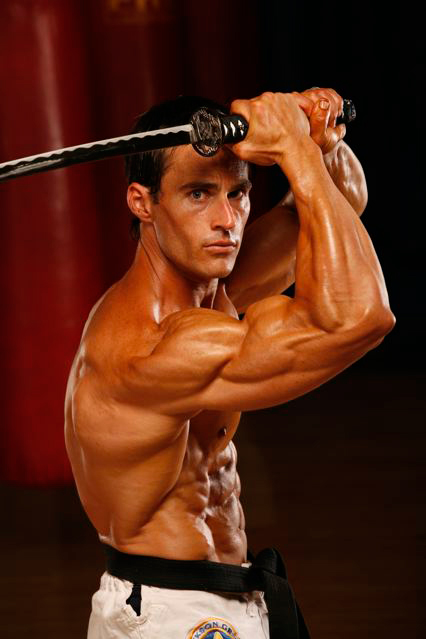The idea that a bodybuilder can get ripped to the bone while eating plenty of carbohydrates may sound ludicrous. Heck, with the overwhelming popularity of low-carb diets, you’d think it would be nearly impossible to eat carbs and shed bodyfat. I say you can shed a lot of fat, and even get ripped, on high carbs as long as you take the right approach.
The first things to consider are two crucial issues: energy deficits and muscle maintenance. Both are integral to a successful high-carb bodybuilding diet.
Create an Energy Deficit
The formula for shedding bodyfat is remarkably simple: When you eat fewer calories than your body needs on a daily basis, you’ll lose bodyfat because it becomes a major source of energy. As long as you keep your total caloric intake below the threshold for bodyweight maintenance, you can lose unwanted bodyfat even while maintaining a relatively higher carbohydrate intake.
Avoid Losing Muscle Mass
When calories drop whether from cutting carbs or from cutting any source of energy the risk is losing muscle. That’s because muscle growth and retention are strongly correlated with calorie surpluses. Maintaining an adequate carb intake (in addition to protein) while lowering your overall intake of calories helps prevent the loss of muscle mass, as carbs spare the breakdown of muscle tissue.
With that in mind, follow these guidelines to drop fat and get cut while enjoying a much higher carb intake than you might expect.

1 | Minimize Dietary Fat
 When you follow a higher-carbohydrate diet to cut up, you must eliminate calories derived from dietary fat. There are two reasons for that. First, you have to create an energy deficit to spark fat burning. By eliminating as much dietary fat as possible, you’ll gain control over your caloric intake. Since many protein foods are also sources of dietary fat, you should emphasize very low-fat protein sources, such as egg whites, protein powders and turkey breast. Good seafood choices include flounder, tuna, hake, scallops and shrimp.
When you follow a higher-carbohydrate diet to cut up, you must eliminate calories derived from dietary fat. There are two reasons for that. First, you have to create an energy deficit to spark fat burning. By eliminating as much dietary fat as possible, you’ll gain control over your caloric intake. Since many protein foods are also sources of dietary fat, you should emphasize very low-fat protein sources, such as egg whites, protein powders and turkey breast. Good seafood choices include flounder, tuna, hake, scallops and shrimp.The second reason to avoid dietary fat concerns insulin. Insulin helps drive fatty acids from dietary fat into fat cells. With an extremely low-fat diet, the body is starved of fatty acids, making it difficult to gain fat as long as calories remain lower.
2 | Choose The Right Carbs
The best carbohydrates for controlling and shedding bodyfat are slow-burning carbs. Slow burners help sidestep insulin bursts. Instead of dramatically kicking up insulin levels which can cause fat storage slow-burning carbs take longer to digest. That favors muscle growth and retention without stimulating the body’s fat-storing machinery. Oatmeal, oat bran cereal, red beans, buckwheat noodles, buckwheat pancakes and red potatoes are some of the best slower-burning won’t-make-you-fat carbs around.
3 | Add Vegetables To The Mix
How can you get slow-burning carbs to digest even more slowly? One way is to consume plenty of vegetables, such as broccoli, cauliflower, cabbage, green beans, wax beans and asparagus. The fiber content of these vegetables can dramatically slow the passage of carbohydrates from the stomach into the intestines, where the carbs are absorbed. Moderating your insulin release will help you lean out your physique.


A good rule of thumb is to add one cup of vegetables for every cup of rice, pasta or potatoes you eat.
Although rice, pasta and potatoes don’t fit the bill as ideal slow-burning carbs, including the right amount of vegetables will slow down the absorption process, allowing for greater fat loss than when eating starchy carbs on their own. Plus, vegetables are filling and low in calories.
4 | Eat Complex Carbs In The Morning
Carbs are less likely to be deposited as bodyfat when you consume them in the morning, because blood sugar and glycogen levels tend to be lower at that time. Lower blood sugar and glycogen levels typically mean the carbs you eat will primarily be stored as muscle and liver glycogen, not bodyfat. For this reason, you can get away with eating more than your fair share of carbs at breakfast, say 75-100 grams (g). Again, emphasize slow-burning complex carbs, such as oatmeal, buckwheat pancakes and whole-grain breads.
5 | Limit Carbs Before Training
This may contradict our customary advice, but keep in mind that this diet plan is different from many we have given you over at Simplyshredded.com. With a high-carb approach to getting cut, you won’t need as many carbs before you work out. The trick here is to encourage your body to use fat as energy, instead of turning to preworkout carbs. When carbs are controlled before training, your body relies on bodyfat as a fuel reserve. The fewer carbs immediately before activity, the more likely you’ll tap additional bodyfat.
6 | Eat More Carbs After Your Workout
 Implementing point five ensures both an increase in fat burning and lower glycogen stores. When glycogen stores fall, carbs are rarely stored as bodyfat. Therefore, include 75-100 g of carbs at the meal following hard training to jump-start recovery and help drive amino acids from protein for muscle repair. Emphasize simple sugars such as dextrose, commonly found in workout shakes, at this time.
Implementing point five ensures both an increase in fat burning and lower glycogen stores. When glycogen stores fall, carbs are rarely stored as bodyfat. Therefore, include 75-100 g of carbs at the meal following hard training to jump-start recovery and help drive amino acids from protein for muscle repair. Emphasize simple sugars such as dextrose, commonly found in workout shakes, at this time.7 | Avoid Carbs At Night
When following a higher-carbohydrate diet to reduce bodyfat, glycogen levels begin to elevate as the day progresses. The closer your glycogen levels are to being “full,” the more readily carbohydrates are stored as bodyfat. For this reason, stick with lean protein and vegetables or a carb-free protein shake for your final meals of the day.
8 | Include Intense Cardio
Unless you have a tremendous metabolic rate, you’ll need cardio work to augment your progress. I recommend only high-intensity cardio to create the greatest calorie burn possible and to stimulate glycogen-storing enzymes. The harder you work, the more calories you’ll burn plus, you’ll increase the activity of glycogen synthase, the enzyme that stores carbohydrates as muscle glycogen. The more you can coax the body to store carbohydrates in muscle, the less likely it will store them as bodyfat.
Build up from your current level to performing cardio at least five days a week for 30-45 minutes. If you have a sluggish metabolic rate, you may need to do even more.
The Prescription
 I recommend that bodybuilders using the high-carb approach set their daily carb intake at 1 1/2 g per pound of bodyweight and peg their protein at 1 g per pound, with as little dietary fat as possible. For a 200-pound athlete, that would mean 300 g of carbohydrates and 200 g of protein daily. A lot of bodybuilders will think it’s impossible to drop serious fat on 300 g of carbs a day, but that’s just carb phobia! Do the math: 300 g of carbs amounts to 1,200 calories and 200 g of protein is only 800 calories. That’s just 2,000 calories a day, give or take another 100-200 from naturally occurring fat found in the protein and carbs you’ll be eating.
I recommend that bodybuilders using the high-carb approach set their daily carb intake at 1 1/2 g per pound of bodyweight and peg their protein at 1 g per pound, with as little dietary fat as possible. For a 200-pound athlete, that would mean 300 g of carbohydrates and 200 g of protein daily. A lot of bodybuilders will think it’s impossible to drop serious fat on 300 g of carbs a day, but that’s just carb phobia! Do the math: 300 g of carbs amounts to 1,200 calories and 200 g of protein is only 800 calories. That’s just 2,000 calories a day, give or take another 100-200 from naturally occurring fat found in the protein and carbs you’ll be eating.
No comments:
Post a Comment